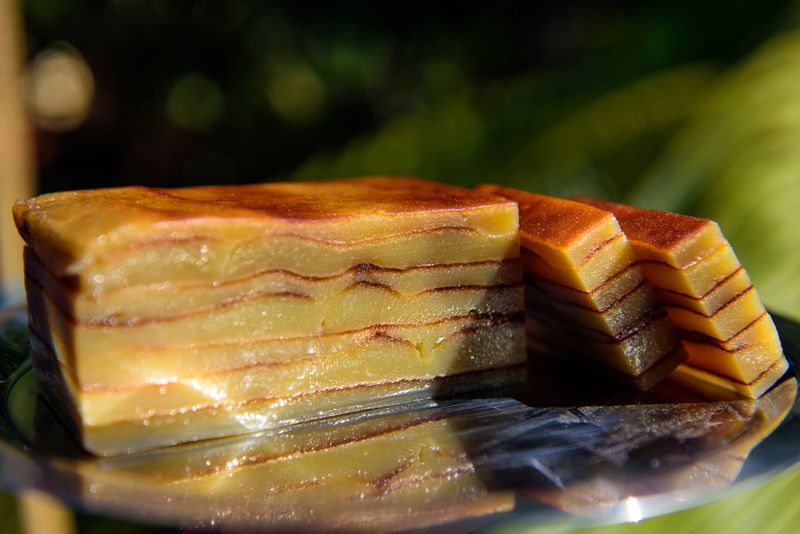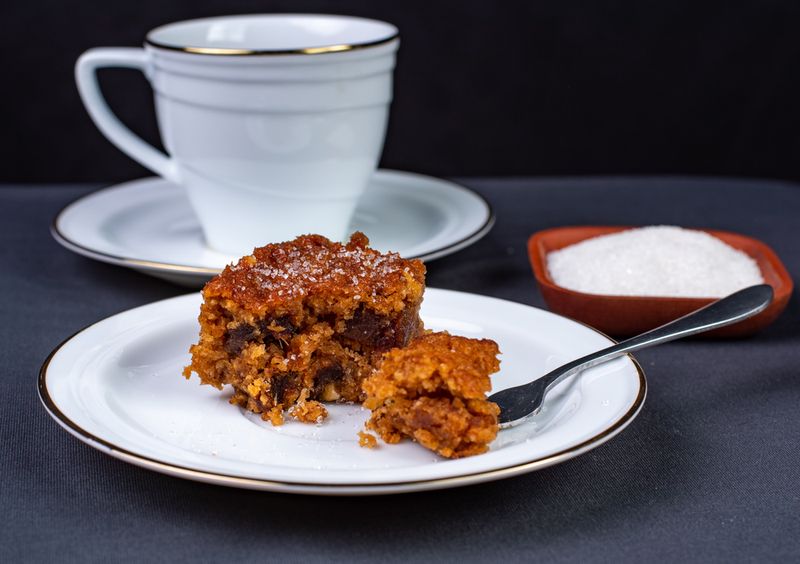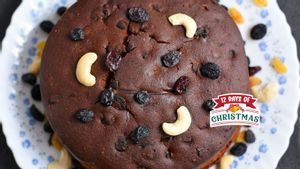A few months ago, Bebinca - the heirloom Goan dessert often dubbed as the Queen of Goan sweets, received a GI tag. Made with a nutmeg-scented batter of rice flour, coconut milk and egg yolks, the Bebinca is a multilayered-treat painstakingly baked one layer at a time, brushed with ghee.

The Bebinca tale
There are a few different theories around the origins of the Bebinca. According to one, recorded in Fatima Di Silva Gracias’s Cozinha de Goa: History and Tradition of Goan Food, in the 17th century, "…the nuns in the Santa Monica Convent in Old Goa used egg whites to starch their habits and the leftover yolks went into make confections. One among them, Sister Bebiana, created a layered cake using the egg yolks to make seven-layered confections - the layers representing the hills of Goa and Lisbon. This cake was named bebinca in her honour.”
However, there’s a general consensus that the Bebinca was born out of Goa’s encounter with the Portuguese, where Goan cooks replaced original ingredients of Portuguese confections with more easily available local ingredients like rice flour and coconut milk. The use of egg yolks is also the leitmotif of Portuguese confections - a tradition rooted in construction of churches that used egg whites in stucco for the walls, resulting in a surfeit of discarded egg yolks. “Egg whites were once used to help make a type of stucco, leaving hundreds, if not thousands of egg yolks looking for something useful to do,” writes Wendy Hutton in The Food of Love - Four Centuries of East West Cuisine.
In her book Curry: A tale of Cooks and Conquerers, Lizzie Collingham writes: “The Bebinca travelled with the Portuguese to Malaya, and from there to the Philippines where the cooks dispensed with the time-consuming layers. From the Philippines, Bebinca continued on its extraordinary journey to Hawaii, where it transmuted into butter mochi, a fudge-like rice-flour dessert.”

Others posit that the word Bebinca is derived from Bingka, a rice flour-based cake of Malay origin, and that it travelled with the Portuguese to India. Whatever the route, versions of the Bebinca variously called Bibik, Vivika, Bibingka etc exists in countries once under Portuguese colonial rule. But even in India, there are several versions of the dish that get overshadowed by the Goan star.
A touch of Kerala
On a recent trip to Kochi, I learnt about Kochi’s own version of the Bebinca, with roots in Fort Kochi’s Luso-Indian community. The Luso-Indians, legally classified as Anglo Indians along with other communities of mixed Indo-European heritage, refer to people of Indo-Portuguese heritage. The Portuguese were the first Europeans to arrive Kochi to trade in spices and went on to rule it for over 160 years. Portuguese soldiers were encouraged to marry local women to create a mixed-race social group that would be faithful to the Portuguese authority. The mixed race born out if these intermarriages eventually came to be called Luso Indians.
Faylene Lobo who lives on Vypin Island, off the shores of Fort Kochi, shares more details about Kochi’s Bebinca that she grew up eating and now makes from time to time for her family, especially on Christmas. An important ingredient in the Bebinca is Kerala’s famed nendran pazham, large bananas that grow prolifically in Kerala. Made with rice flour, coconut milk and Kerala bananas, the Fort-Kochi Bebinca also comes scented with freshly grated nutmeg. Only a smidgen of butter is added to the batter, which is then baked. “The Bebinca was originally baked in an uruli that would be filled with sand, covered and burning coal would be places both on top and under,” says restaurateur Crescentia Scolt Fernandez, an Anglo-Indian from Kochi of Dutch-Portuguese lineage and married to a Goan.

Pondicherry pitstop
On another trip to Puducherry, erstwhile Pondicherry, a few years ago I dropped by Motchamary Pushpam’s (aka Pushpa) lovely home for a cookery class and table d’hôte lunch to learn about the nuances of Pondicherry’s Creole Cuisine - a mix of French, Tamil, Portuguese, Dutch, Mughal and even Vietnamese cuisine. Pushpa told me about the Vivikam or Vivika - a rich cake made with roasted semolina, coconut milk and pure ghee, the rich, and comes chockfull with rum (or brandy)-soaked cashew nuts and raisins, candied fruits and citrus peels. Also known as the Pondicherry Christmas Cake, it is traditionally served with a glass of cognac on Christmas eve.”
The Pondicherry Vivikam shares some common features with the Sri Lankan Bibikkan, a similar cake, a burnished brown in colour, widely believed to have been a Portuguese import to the island country. Bibikkan, “also popular among the Sinhalese who know it by the same name is a rich brownish cake made of rice flour, roasted and pounded green gram, scraped coconut, jaggery, sugar and sweet cumin,” writes Asia Hussein in his 2007-book Sarandib: An Ethnological Study of the Muslims of Sri Lanka.

The Bong connection
Interestingly, an 1898 Bengali cookbook titled Mistanna Paak by Bipradas Mukhopadhyay features a recipe for Portuguese Bebinca Dosi. The recipe calls for preparing a batter of rice flour and coconut milk in sugar syrup single-thread consistency, which is then simmer in ghee or butter, in a pan until it reaches a thick consistency. It is then allowed to cool down and eaten. The author recommends substituting rice flour with semolina along with almonds, raisins and pistachios for best results.
But it is across the border in present day Bangladesh that you find the Bengali-creole version of the Bebinca - Bibikhana pitha. In Bengal, pitha typically refers to dumplings and pancakes of various kinds, steamed or fried, stuffed or not, typically made with rice flour, coconut, lentils, jaggery etc. The Bibikhana pitha is an exception. It is more of a cardamom-scented cake made with rice flour, coconut, Bengal’s famed new date palm jaggery or nolen gur, eggs and ghee. A version of the Bibikhana comes infused with the golden pulp of Palmyra palm too. Bibikhana, is sometimes referred to as Badshahi pitha insinuating at the possibility of influence from Muslim kitchens perhaps due to the use of eggs, as also the name that sounds quite like a Perso-Indian compound. Bibi, a Persian loan word to Urdu means lady of the house and the khana rooted in Sanskrit khad refers to food in Indian languages like Hindi and Urdu. However, it is difficult to ignore the similarity of Bibikhana and Bibikkan or Bebinca, and there are reasons to believe that Bibikhana is a colloquial distortion.
After all, undivided Bengal has also been home to Portuguese colonists, and in Bengal, the Portuguese were known for their trade in confectioneries. Francois Bernier, who travelled across undivided Bengal in 1665, wrote: “Bengal is a place of good comfits, especially in those places where the Portuguese are, who are dexterous in making them and drive a great trade in them.”
Collingham, further writes, “Bengal was well supplied with bakers’ shops selling light and crumbly pastries and delicately flavoured egg confections to the eager Bengalis who were renowned for their passion for sweets.”
Besides, Bikrampur, the Bangladeshi town synonymous with Bibikhana pitha, is close to Dhaka where the Portuguese arrived as early as the 1580s. Bikrampur itself saw an influx of Portuguese, especially in the form of mercenaries who joined the army of Raja Kedar Ray, the ruler of the area, to fight against the Mughals. Further clue to Bibikhana’s Portuguese lineage comes in the book Bride and the Demand System in Bangladesh, where authors Rahnuma Ahmed and Milu Shamsun Naher mention Bibikhana pitha as a dish specially made in Christian homes, including on Christmas Eve, and as distinct the pithas prepared in Muslim homes on special occasions and festivals like Eid.

And… back to Goa
Even if it’s the layered Bebinca that is synonymous with Goa, Goa has other versions sans the layers, says Fernandez. One among them is made with potatoes. “Potatoes are boiled and mashed up before being folded into a batter of egg yolks and coconut milk, a little maida and sugar. It’s then baked until it sets,” she adds. Sweet potatoes are also used to make a similar Bebinca. Di Silva’s book also features other iterations of the Bebinca like the Bebinca de Favos de Mel or Honeycomb Bebinca and Bebinca de Clara made with egg whites instead of egg yolks.
Bebinca in its many avatars is a shining example of culinary creolisation. Creolisation, as professor Ananya Jahanara Kabir explains is “the creation of something new (innovation) through exchange, negotiation, collaboration, and compromise’, “when a whole lot of different groups meet, mingle and exchange with each other in tightly demarcated spaces: such as the clusters of European settlements along India’s coastlines and broad riverways like the Hooghly.”
Kabir also points out that the new kind of dish that emerges is often called different things in different places - what we see is variations on a theme, and indeed…. variations on a theme. This too is a feature of creolisation, whether of language or food: creole products resist standardisation and force us to find another kind of logic to explicate connections.,” says Kabir.
In this case, the common strains include the replacement of wheat flour with more commonly available rice flour, and butter with ghee, the addition of coconut milk instead of dairy and in many cases, the local accents the cake picked up through ingredients such as the nendra banana or Bengal’s nolen gur. Layered or not, it’s a culinary heirloom steeped in history and embedded with colonial memories. And it’s delicious.
Disclaimer: The views expressed in the article reflects the author(s) opinions and do not necessarily represent the views of the publisher and editor.


_1708669252354_thumb_1200.jpeg?w=3840&q=75)
